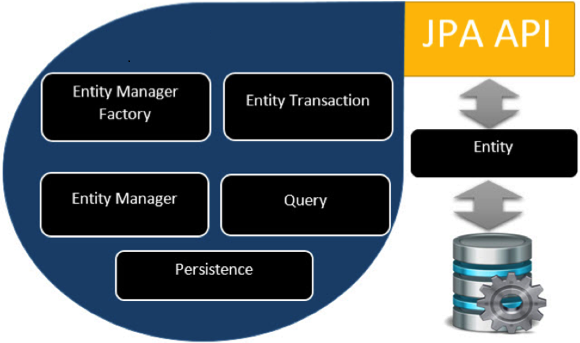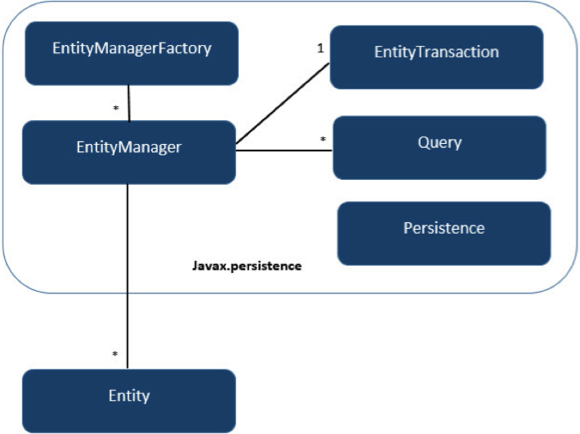
JPA - Persistence Operations
- JPA - Entity Managers
- JPA - Create Employee Example
- JPA - Update Employee Example
- JPA - Find Employee Example
- JPA - Delete Employee Example
- JPA - Criteria API
JPA - JPQL
- JPA - JPQL
- JPA - Scalar Function
- JPA - Aggregate Function
- JPA - Between Keyword
- JPA - Like Keyword
- JPA - Order By Clause
- JPA - Named Query
JPA - Advanced Mappings
- JPA - Advanced Mappings
- JPA - Single Table Strategy
- JPA - Joined Table Strategy
- JPA - Table per Class Strategy
JPA - Entity Relationships
- JPA - Entity Relationships
- JPA - @ManyToOne Relationships
- JPA - @OneToMany Relationships
- JPA - @OneToOne Relationships
- JPA - @ManyToMany Relationships
JPA - Useful Resources
JPA - Architecture
Java Persistence API or Jakarta Persistance API is a source to store business entities as relational entities. It shows how to define a PLAIN OLD JAVA OBJECT (POJO) as an entity and how to manage entities with relations.
Class Level Architecture
The following image shows the class level architecture of JPA. It shows the core classes and interfaces of JPA.

The following table describes each of the units shown in the above architecture.
| Units | Description |
|---|---|
| EntityManagerFactory | This is a factory class of EntityManager. It creates and manages multiple EntityManager instances. |
| EntityManager | It is an Interface, it manages the persistence operations on objects. It works like factory for Query instance. |
| Entity | Entities are the persistence objects, stores as records in the database. |
| EntityTransaction | It has one-to-one relationship with EntityManager. For each EntityManager, operations are maintained by EntityTransaction class. |
| Persistence | This class contain static methods to obtain EntityManagerFactory instance. |
| Query | This interface is implemented by each JPA vendor to obtain relational objects that meet the criteria. |
The above classes and interfaces are used for storing entities into a database as a record. They help programmers by reducing their efforts to write codes for storing data into a database so that they can concentrate on more important activities such as writing codes for mapping the classes with database tables.
JPA Class Relationships
In the above architecture, the relations between the classes and interfaces belong to the jakarta.persistence package. The following diagram shows the relationship between them.

The relationship between EntityManagerFactory and EntityManager is one-to-many. It is a factory class to EntityManager instances.
The relationship between EntityManager and EntityTransaction is one-to-one. For each EntityManager operation, there is an EntityTransaction instance.
The relationship between EntityManager and Query is one-to-many. Many number of queries can execute using one EntityManager instance.
The relationship between EntityManager and Entity is one-to-many. One EntityManager instance can manage multiple Entities.